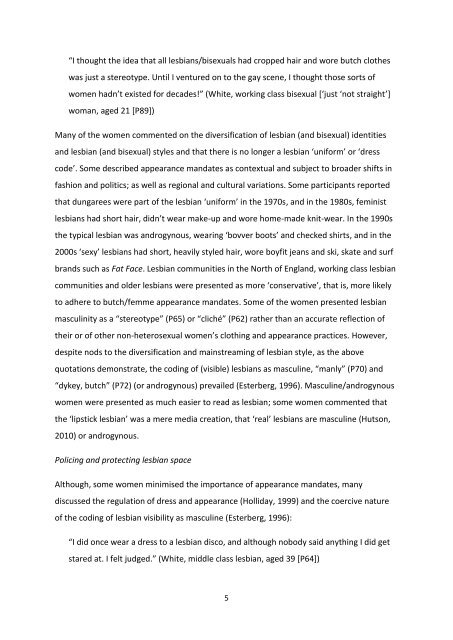Clarke, V. and Spence, K. (2012) I am who I am? Navigating norms ...
Clarke, V. and Spence, K. (2012) I am who I am? Navigating norms ...
Clarke, V. and Spence, K. (2012) I am who I am? Navigating norms ...
Create successful ePaper yourself
Turn your PDF publications into a flip-book with our unique Google optimized e-Paper software.
“I thought the idea that all lesbians/bisexuals had cropped hair <strong>and</strong> wore butch clothes<br />
was just a stereotype. Until I ventured on to the gay scene, I thought those sorts of<br />
women hadn’t existed for decades!” (White, working class bisexual [‘just ‘not straight’]<br />
woman, aged 21 [P89])<br />
Many of the women commented on the diversification of lesbian (<strong>and</strong> bisexual) identities<br />
<strong>and</strong> lesbian (<strong>and</strong> bisexual) styles <strong>and</strong> that there is no longer a lesbian ‘uniform’ or ‘dress<br />
code’. Some described appearance m<strong>and</strong>ates as contextual <strong>and</strong> subject to broader shifts in<br />
fashion <strong>and</strong> politics; as well as regional <strong>and</strong> cultural variations. Some participants reported<br />
that dungarees were part of the lesbian ‘uniform’ in the 1970s, <strong>and</strong> in the 1980s, feminist<br />
lesbians had short hair, didn’t wear make-up <strong>and</strong> wore home-made knit-wear. In the 1990s<br />
the typical lesbian was <strong>and</strong>rogynous, wearing ‘bovver boots’ <strong>and</strong> checked shirts, <strong>and</strong> in the<br />
2000s ‘sexy’ lesbians had short, heavily styled hair, wore boyfit jeans <strong>and</strong> ski, skate <strong>and</strong> surf<br />
br<strong>and</strong>s such as Fat Face. Lesbian communities in the North of Engl<strong>and</strong>, working class lesbian<br />
communities <strong>and</strong> older lesbians were presented as more ‘conservative’, that is, more likely<br />
to adhere to butch/femme appearance m<strong>and</strong>ates. Some of the women presented lesbian<br />
masculinity as a “stereotype” (P65) or “cliché” (P62) rather than an accurate reflection of<br />
their or of other non-heterosexual women’s clothing <strong>and</strong> appearance practices. However,<br />
despite nods to the diversification <strong>and</strong> mainstre<strong>am</strong>ing of lesbian style, as the above<br />
quotations demonstrate, the coding of (visible) lesbians as masculine, “manly” (P70) <strong>and</strong><br />
“dykey, butch” (P72) (or <strong>and</strong>rogynous) prevailed (Esterberg, 1996). Masculine/<strong>and</strong>rogynous<br />
women were presented as much easier to read as lesbian; some women commented that<br />
the ‘lipstick lesbian’ was a mere media creation, that ‘real’ lesbians are masculine (Hutson,<br />
2010) or <strong>and</strong>rogynous.<br />
Policing <strong>and</strong> protecting lesbian space<br />
Although, some women minimised the importance of appearance m<strong>and</strong>ates, many<br />
discussed the regulation of dress <strong>and</strong> appearance (Holliday, 1999) <strong>and</strong> the coercive nature<br />
of the coding of lesbian visibility as masculine (Esterberg, 1996):<br />
“I did once wear a dress to a lesbian disco, <strong>and</strong> although nobody said anything I did get<br />
stared at. I felt judged.” (White, middle class lesbian, aged 39 [P64])<br />
5

















